Extracellular polysaccharides purified from Aureobasidium pullulans SM‑2001 (Polycan) inhibit dexamethasone‑induced muscle atrophy in mice
- Authors:
- Jong‑Min Lim
- Young Joon Lee
- Hyung‑Rae Cho
- Dong‑Chan Park
- Go‑Woon Jung
- Sae Kwang Ku
- Jae‑Suk Choi
-
Affiliations: Glucan Corporation, #305 Marine Bio‑Industry Development Center, Busan 46048, Republic of Korea, Department of Preventive Medicine, College of Korean Medicine, Daegu Haany University, Gyeongsan‑si, Gyeongsangbuk‑do 38610, Republic of Korea, Department of Anatomy and Histology, College of Korean Medicine, Daegu Haany University, Gyeongsan‑si, Gyeongsangbuk‑do 38610, Republic of Korea, Major in Food Biotechnology, Division of Bioindustry, College of Medical and Life Sciences, Silla University, Busan 46958, Republic of Korea - Published online on: November 10, 2017 https://doi.org/10.3892/ijmm.2017.3251
- Pages: 1245-1264
-
Copyright: © Lim et al. This is an open access article distributed under the terms of Creative Commons Attribution License.
This article is mentioned in:
Abstract
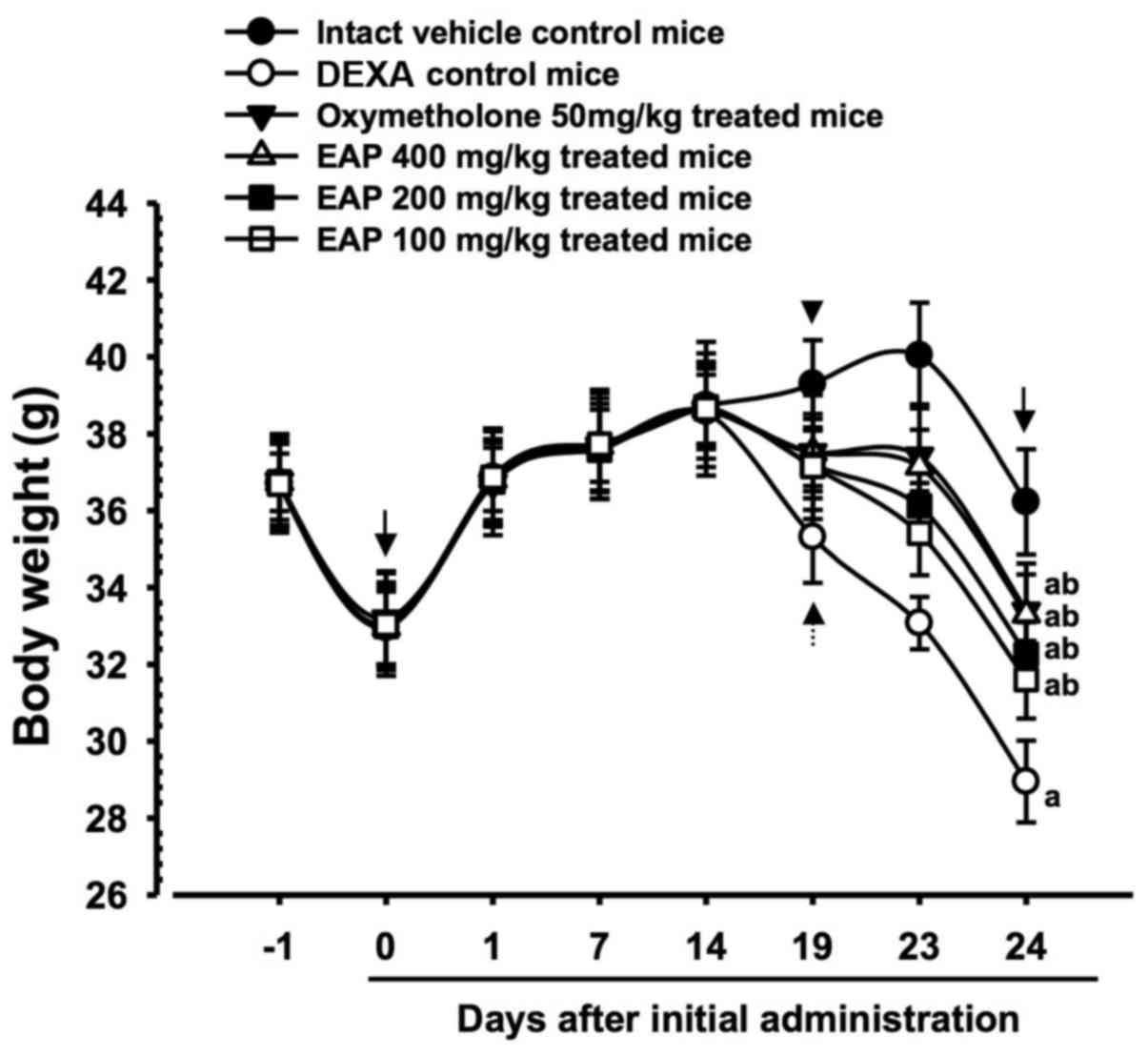 |
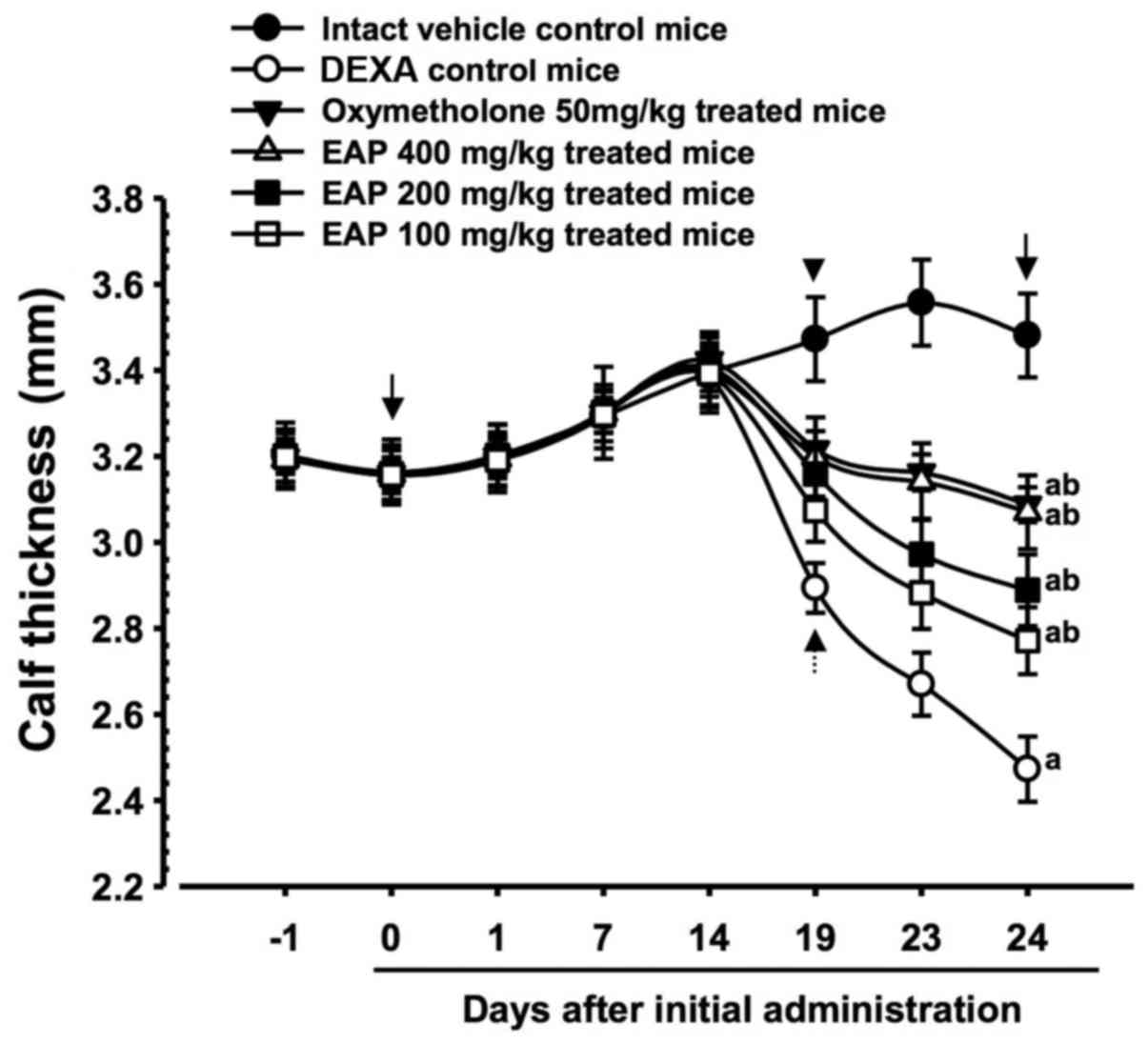 |
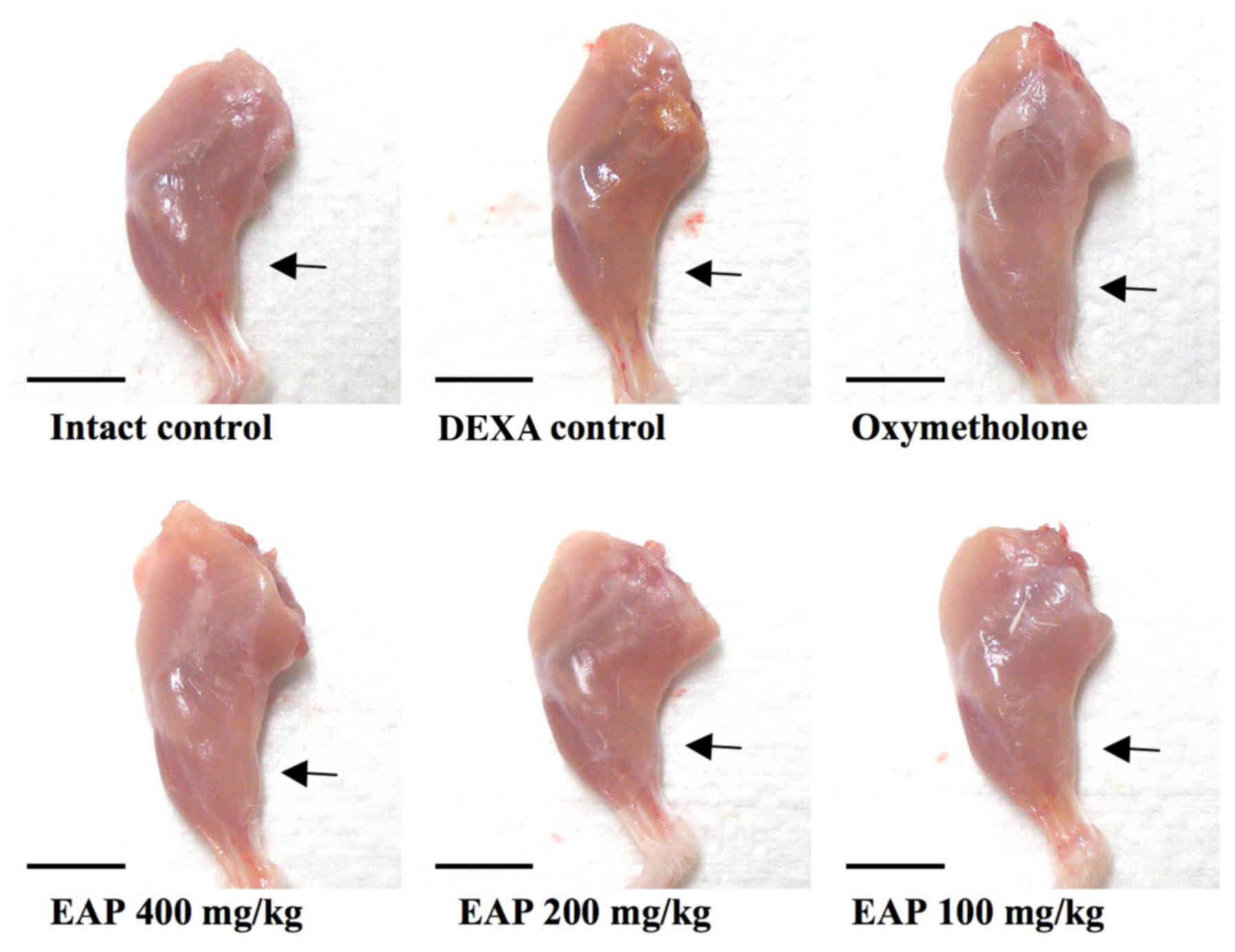 |
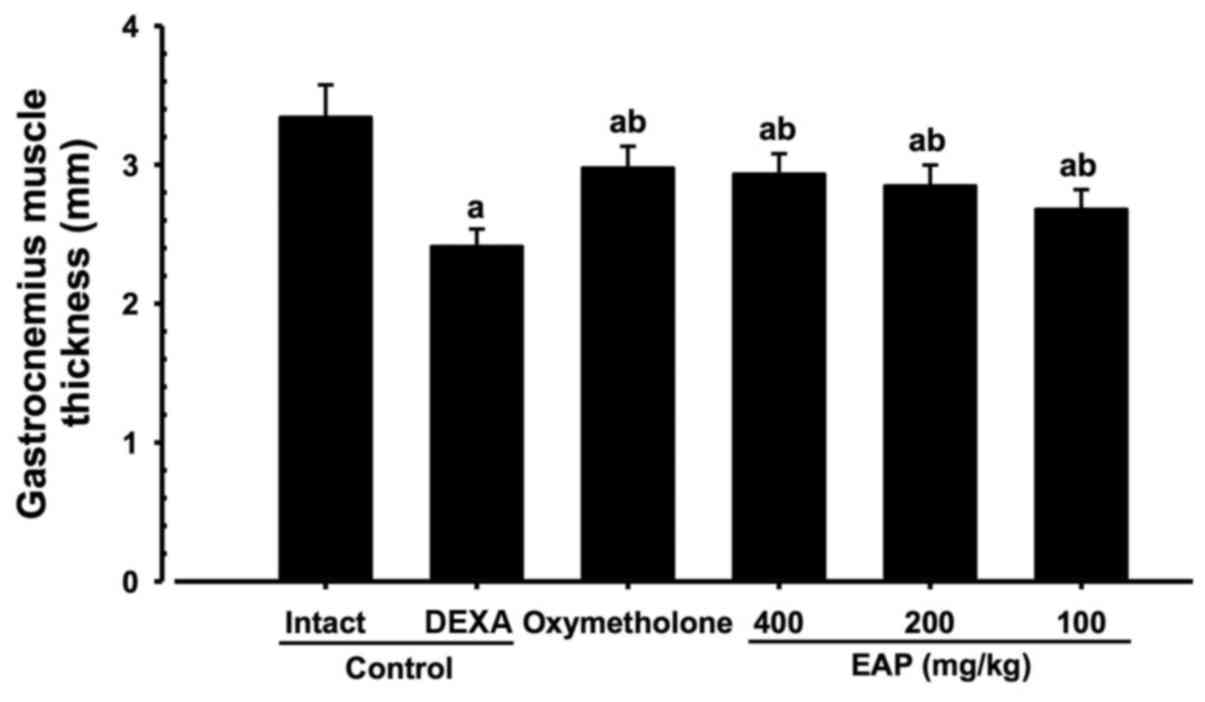 |
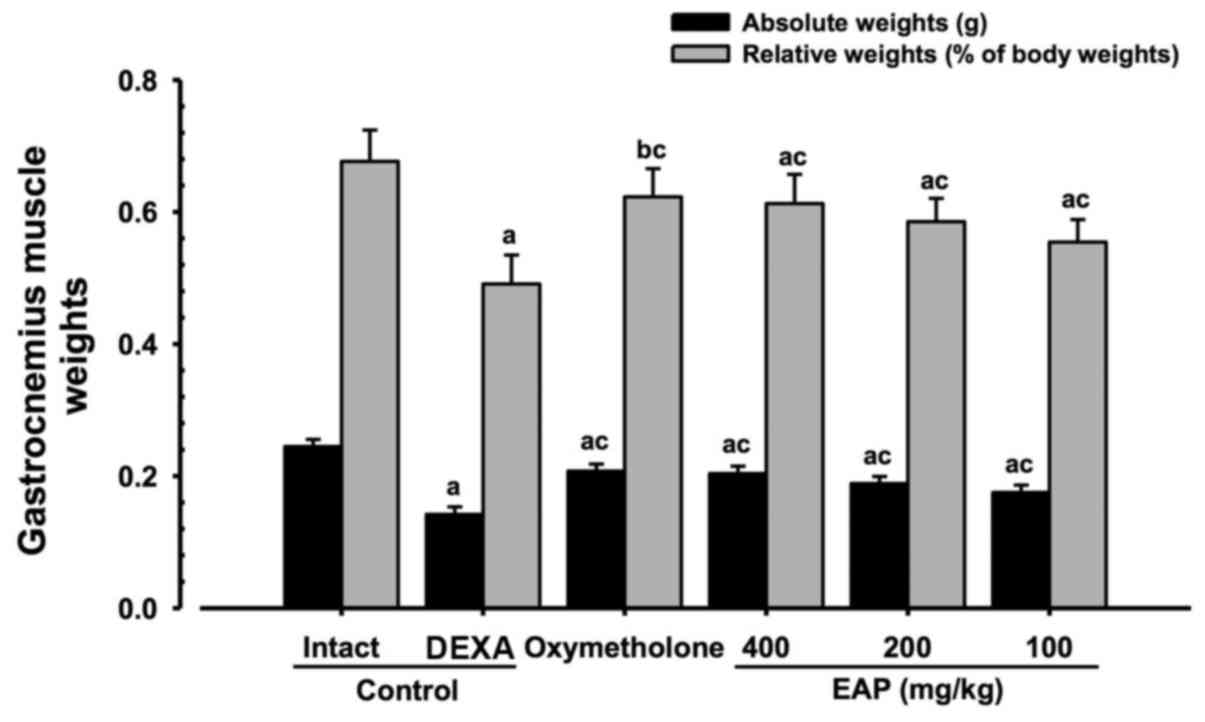 |
 |
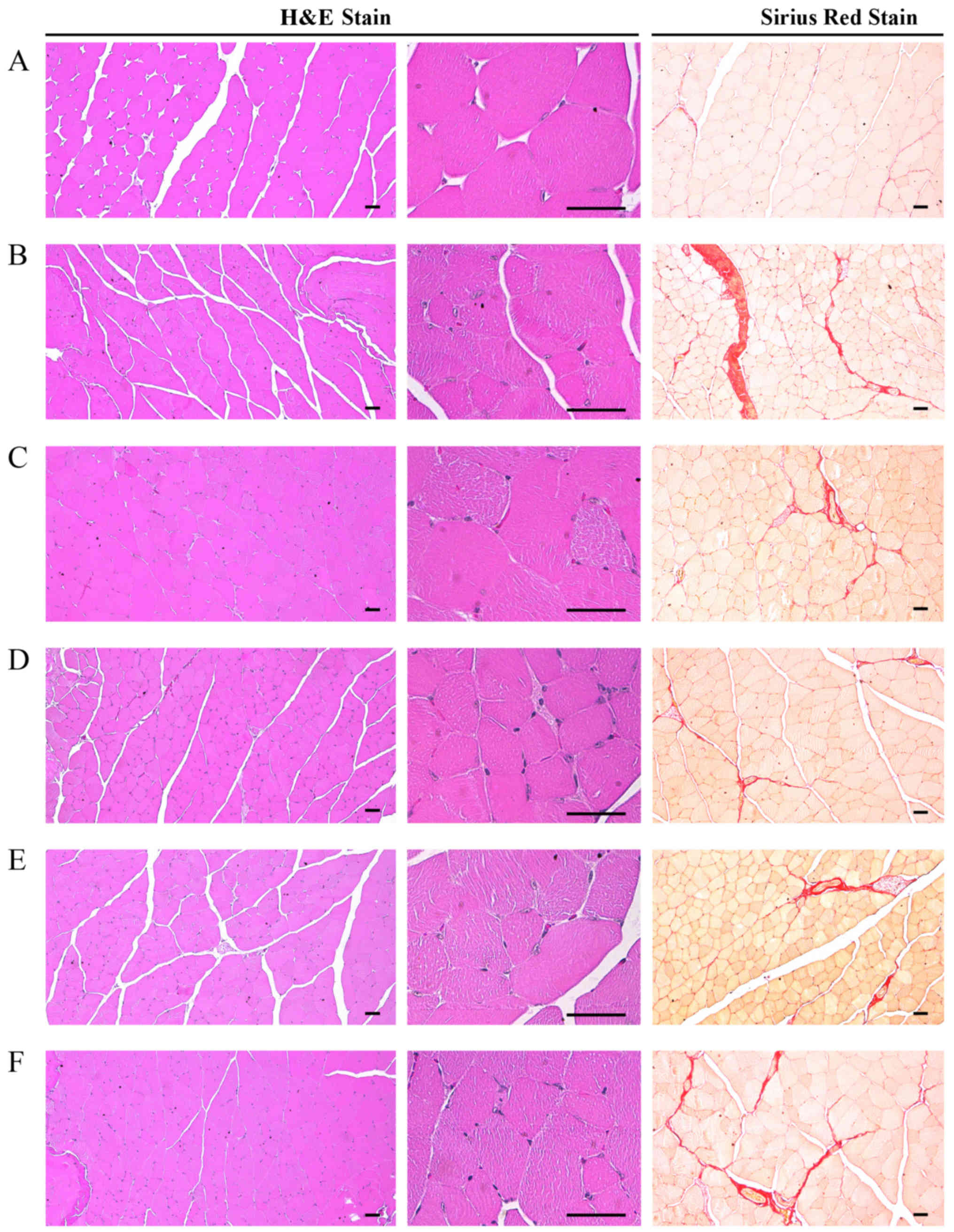 |
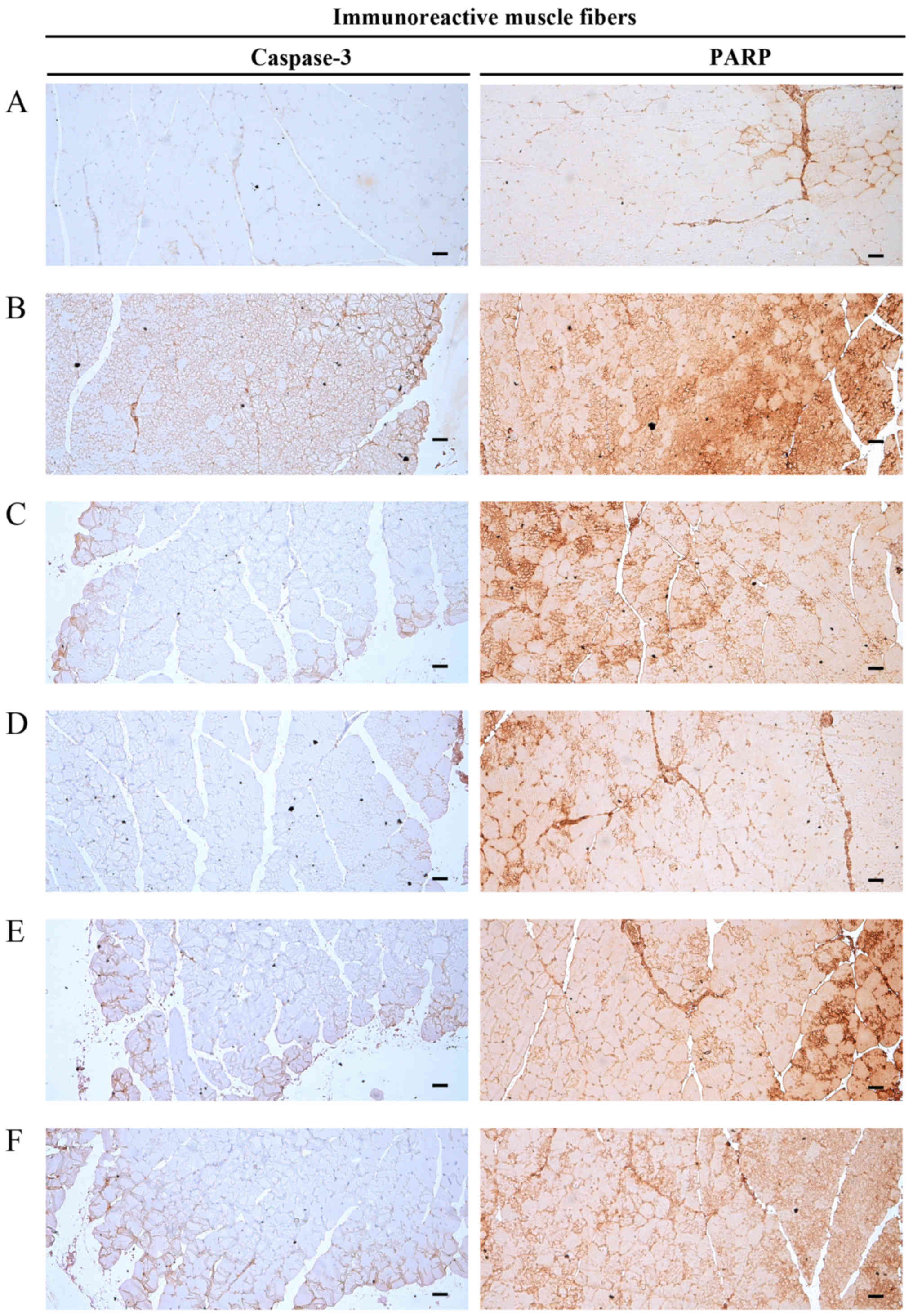 |
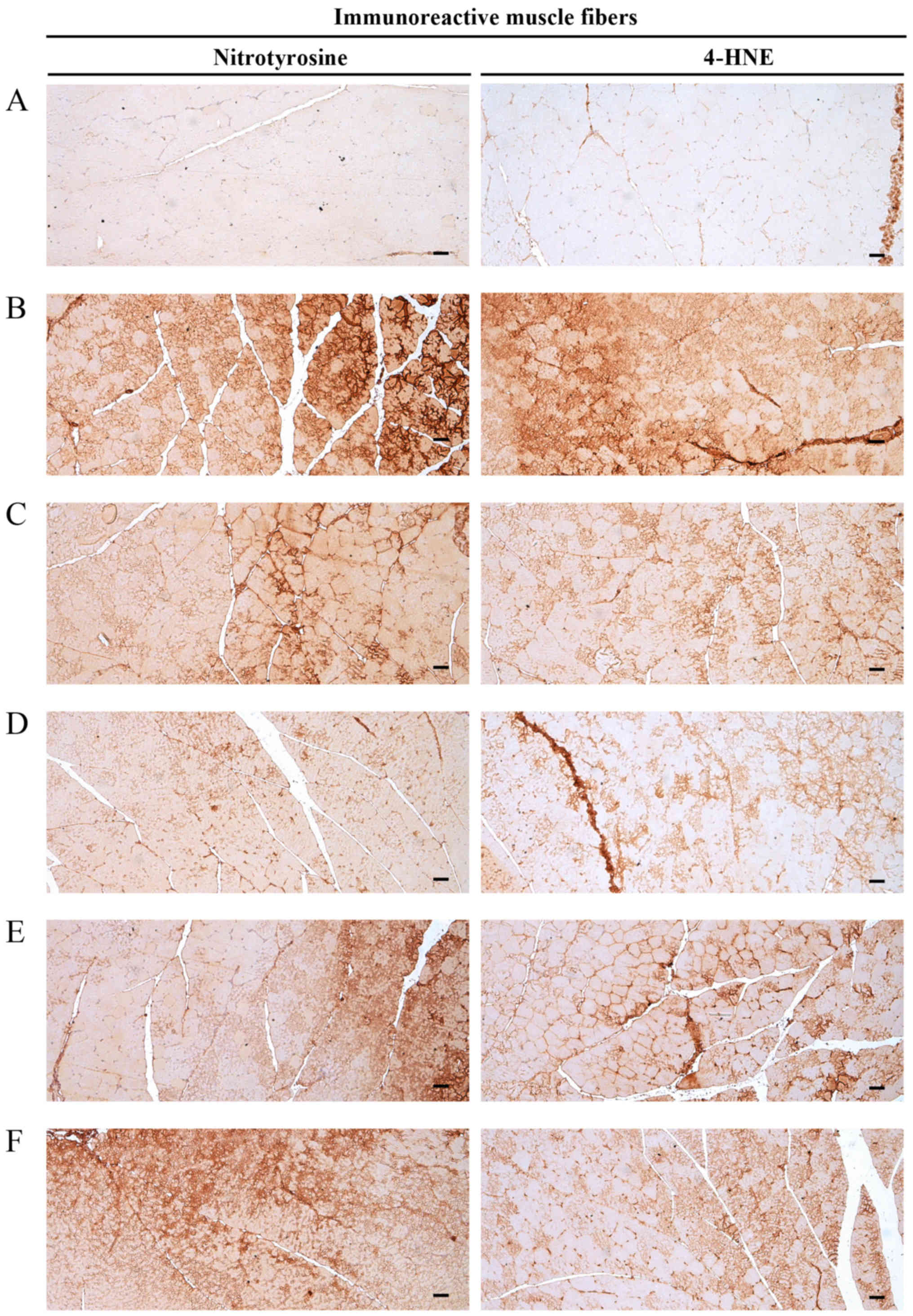 |
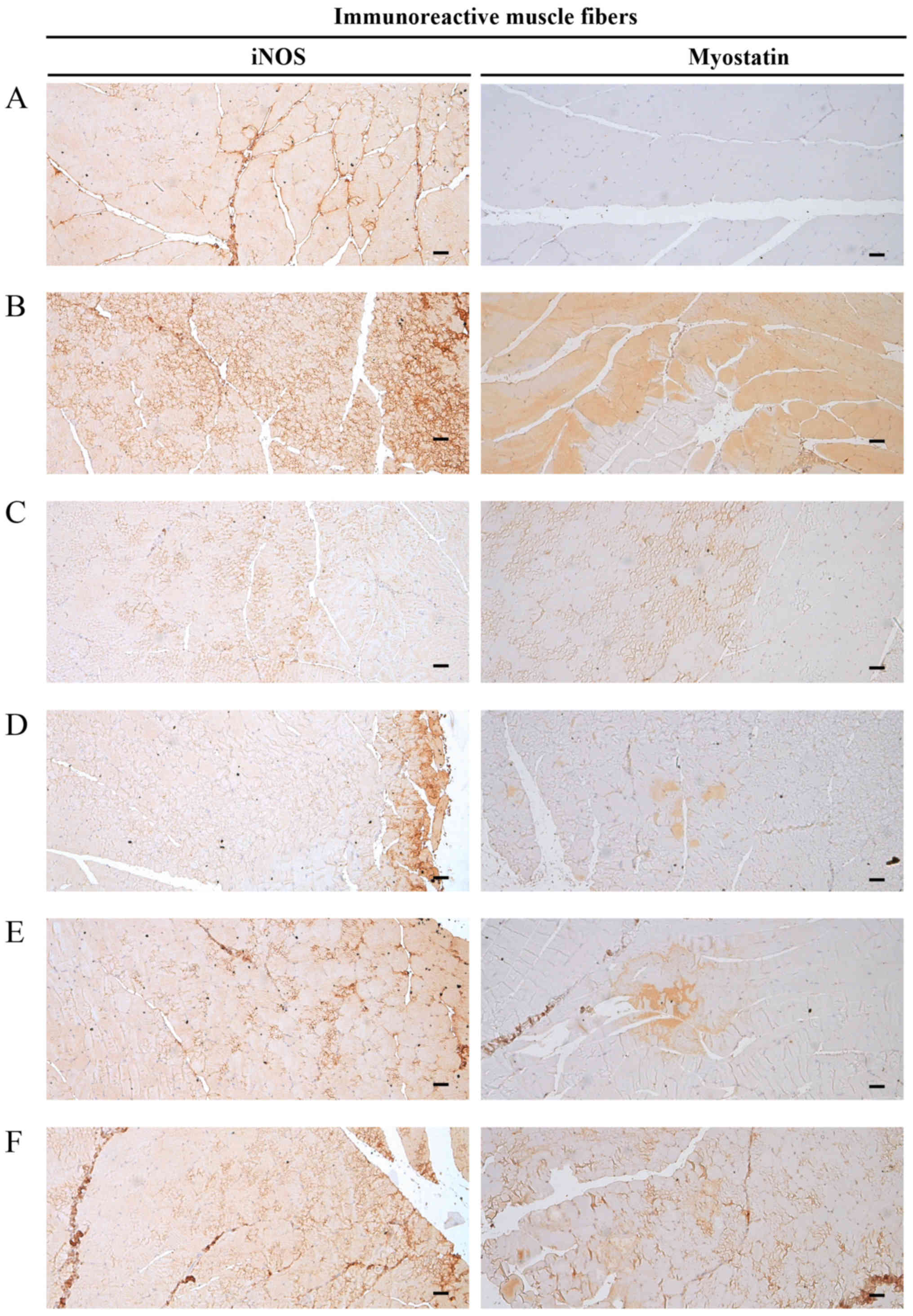 |
|
Brooks SV and Faulkner JA: Skeletal muscle weakness in old age: Underlying mechanisms. Med Sci Sports Exerc. 26:432–439. 1994. View Article : Google Scholar : PubMed/NCBI | |
|
Frontera WR, Hughes VA, Fielding RA, Fiatarone MA, Evans WJ and Roubenoff R: Aging of skeletal muscle: A 12-yr longitudinal study. J Appl Physiol. 88:1321–1326. 2000. View Article : Google Scholar : PubMed/NCBI | |
|
Metter EJ, Talbot LA, Schrager M and Conwit R: Skeletal muscle strength as a predictor of all-cause mortality in healthy men. J Gerontol A Biol Sci Med Sci. 57:B359–B365. 2002. View Article : Google Scholar : PubMed/NCBI | |
|
Glass DJ: Molecular mechanisms modulating muscle mass. Trends Mol Med. 9:344–350. 2003. View Article : Google Scholar : PubMed/NCBI | |
|
Bodine SC, Latres E, Baumhueter S, Lai VK, Nunez L, Clarke BA, Poueymirou WT, Panaro FJ, Na E, Dharmarajan K, et al: Identification of ubiquitin ligases required for skeletal muscle atrophy. Science. 294:1704–1708. 2001. View Article : Google Scholar : PubMed/NCBI | |
|
Glass DJ: Skeletal muscle hypertrophy and atrophy signaling pathways. Int J Biochem Cell Biol. 37:1974–1984. 2005. View Article : Google Scholar : PubMed/NCBI | |
|
Ramírez C, Russo TL, Sandoval MC, Dentillo AA, Couto MA, Durigan JL and Salvini TF: Joint inflammation alters gene and protein expression and leads to atrophy in the tibialis anterior muscle in rats. Am J Phys Med Rehabil. 90:930–939. 2011. View Article : Google Scholar : PubMed/NCBI | |
|
Hofer T, Marzetti E, Xu J, Seo AY, Gulec S, Knutson MD, Leeuwenburgh C and Dupont-Versteegden EE: Increased iron content and RNA oxidative damage in skeletal muscle with aging and disuse atrophy. Exp Gerontol. 43:563–570. 2008. View Article : Google Scholar : PubMed/NCBI | |
|
Onda A, Jiao Q, Nagano Y, Akimoto T, Miyamoto T, Minamisawa S and Fukubayashi T: Acupuncture ameliorated skeletal muscle atrophy induced by hindlimb suspension in mice. Biochem Biophys Res Commun. 410:434–439. 2011. View Article : Google Scholar : PubMed/NCBI | |
|
Booth FW: Physiologic and biochemical effects of immobilization on muscle. Clin orthop Relat Res. 219:15–20. 1987. | |
|
Thomas DR: Loss of skeletal muscle mass in aging: Examining the relationship of starvation, sarcopenia and cachexia. Clin Nutr. 26:389–399. 2007. View Article : Google Scholar : PubMed/NCBI | |
|
Léger B, Senese R, Al-Khodairy AW, Dériaz O, Gobelet C, Giacobino JP and Russell AP: Atrogin-1, MuRF1, and FoXo, as well as phosphorylated GSK-3beta and 4EBP1 are reduced in skeletal muscle of chronic spinal cord-injured patients. Muscle Nerve. 40:69–78. 2009. View Article : Google Scholar | |
|
Kawano F, Tanihata J, Sato S, Nomura S, Shiraishi A, Tachiyashiki K and Imaizumi K: Effects of dexamethasone on the expression of beta(1)-, beta (2)- and beta (3)-adrenoceptor mRNAs in skeletal and left ventricle muscles in rats. J Physiol Sci. 59:383–390. 2009. View Article : Google Scholar : PubMed/NCBI | |
|
Dardevet D, Sornet C, Savary I, Debras E, Patureau-Mirand P and Grizard J: Glucocorticoid effects on insulin- and IGF-I-regulated muscle protein metabolism during aging. J Endocrinol. 156:83–89. 1998. View Article : Google Scholar : PubMed/NCBI | |
|
Kanda F, Takatani K, Okuda S, Matsushita T and Chihara K: Preventive effects of insulinlike growth factor-I on steroid-induced muscle atrophy. Muscle Nerve. 22:213–217. 1999. View Article : Google Scholar : PubMed/NCBI | |
|
Gilson H, Schakman O, Combaret L, Lause P, Grobet L, Attaix D, Ketelslegers JM and Thissen JP: Myostatin gene deletion prevents glucocorticoid-induced muscle atrophy. Endocrinology. 148:452–460. 2007. View Article : Google Scholar | |
|
Auclair D, Garrel DR, Chaouki Zerouala A and Ferland LH: Activation of the ubiquitin pathway in rat skeletal muscle by catabolic doses of glucocorticoids. Am J Physiol. 272:C1007–C1016. 1997. View Article : Google Scholar : PubMed/NCBI | |
|
Hasselgren PO: Glucocorticoids and muscle catabolism. Curr Opin Clin Nutr Metab Care. 2:201–205. 1999. View Article : Google Scholar : PubMed/NCBI | |
|
Komamura K, Shirotani-Ikejima H, Tatsumi R, Tsujita-Kuroda Y, Kitakaze M, Miyatake K, Sunagawa K and Miyata T: Differential gene expression in the rat skeletal and heart muscle in glucocorticoid-induced myopathy: Analysis by microarray. Cardiovasc Drugs Ther. 17:303–310. 2003. View Article : Google Scholar : PubMed/NCBI | |
|
McPherron AC, Lawler AM and Lee SJ: Regulation of skeletal muscle mass in mice by a new TGF-β superfamily member. Nature. 387:83–90. 1997. View Article : Google Scholar : PubMed/NCBI | |
|
Qin J, Du R, Yang YQ, Zhang HQ, Li Q, Liu L, Guan H, Hou J and An XR: Dexamethasone-induced skeletal muscle atrophy was associated with upregulation of myostatin promoter activity. Res Vet Sci. 94:84–89. 2013. View Article : Google Scholar | |
|
Allen DL, Bandstra ER, Harrison BC, Thorng S, Stodieck LS, Kostenuik PJ, Morony S, Lacey DL, Hammond TG, Leinwand LL, et al: Effects of spaceflight on murine skeletal muscle gene expression. J Appl Physiol 1985. 106:582–595. 2009. View Article : Google Scholar : | |
|
Dirks-Naylor AJ and Griffiths CL: Glucocorticoid-induced apoptosis and cellular mechanisms of myopathy. J Steroid Biochem Mol Biol. 117:1–7. 2009. View Article : Google Scholar : PubMed/NCBI | |
|
Orzechowski A, Ostaszewski P, Wilczak J, Jank M, Bałasińska B, Wareski P and Fuller J Jr: Rats with a glucocorticoid-induced catabolic state show symptoms of oxidative stress and spleen atrophy: The effects of age and recovery. J Vet Med A Physiol Pathol Clin Med. 49:256–263. 2002. View Article : Google Scholar : PubMed/NCBI | |
|
Alamdari N, Aversa Z, Castillero E, Gurav A, Petkova V, Tizio S and Hasselgren PO: Resveratrol prevents dexamethasone-induced expression of the muscle atrophy-related ubiquitin ligases atrogin-1 and MuRF1 in cultured myotubes through a SIRT1-dependent mechanism. Biochem Biophys Res Commun. 417:528–533. 2012. View Article : Google Scholar : | |
|
Kim JW, Ku SK, Han MH, Kim KY, Kim SG, Kim GY, Hwang HJ, Kim BW, Kim CM and Choi YH: The administration of Fructus Schisandrae attenuates dexamethasone-induced muscle atrophy in mice. Int J Mol Med. 36:29–42. 2015a. View Article : Google Scholar | |
|
Benveniste O, Jacobson L, Farrugia ME, Clover L and Vincent A: MuSK antibody positive myasthenia gravis plasma modifies MURF-1 expression in C2C12 cultures and mouse muscle in vivo. J Neuroimmunol. 170:41–48. 2005. View Article : Google Scholar : PubMed/NCBI | |
|
Jones A, Hwang DJ, Narayanan R, Miller DD and Dalton JT: Effects of a novel selective androgen receptor modulator on dexa-methasone-induced and hypogonadism-induced muscle atrophy. Endocrinology. 151:3706–3719. 2010. View Article : Google Scholar : PubMed/NCBI | |
|
Yang Z, Nakagawa K, Sarkar A, Maruyama J, Iwasa H, Bao Y, Ishigami-Yuasa M, Ito S, Kagechika H, Hata S, et al: Screening with a novel cell-based assay for TAZ activators identifies a compound that enhances myogenesis in C2C12 cells and facilitates muscle repair in a muscle injury model. Mol Cell Biol. 34:1607–1621. 2014. View Article : Google Scholar : PubMed/NCBI | |
|
Ringold HJ, Batres E, Halpern O and Necoechea E: Steroids. CV. 12-Methyl and 2-hydroxymethylene-androstane derivatives. J Am Chem Soc. 81:427–432. 1959. View Article : Google Scholar | |
|
Lennon HD: Effects of various 17-alpha-alkyl substitutions and structural modifications of steroids on sulfobromophthalein (BSP) retention in rabbits. Steroids. 7:157–170. 1966. View Article : Google Scholar : PubMed/NCBI | |
|
Dorfman RI and Kincl FA: Relative potency of steroids in an anabolic-androgenic assay using the castrated rat. Endocrinology. 72:259–266. 1963. View Article : Google Scholar | |
|
Pavlatos AM, Fultz O, Monberg MJ and Vootkur A: Review of oxymetholone: A 17alpha-alkylated anabolic-androgenic steroid. Clin Ther. 23:789–801; discussion 771. 2001. View Article : Google Scholar : PubMed/NCBI | |
|
Isaacs J, Loveland K, Mallu S, Adams S and Wodicka R: The use of anabolic steroids as a strategy in reversing denervation atrophy after delayed nerve repair. Hand (NY). 6:142–148. 2011. View Article : Google Scholar | |
|
Kim JW, Ku SK, Kim KY, Kim SG, Han MH, Kim GY, Hwang HJ, Kim BW, Kim CM and Choi YH: Schisandrae Fructus supplementation ameliorates sciatic neurectomy-induced muscle atrophy in mice. Oxid Med Cell Longev. 2015:8724282015. View Article : Google Scholar : PubMed/NCBI | |
|
Young GP, Bhathal PS, Sullivan JR, Wall AJ, Fone DJ and Hurley TH: Fatal hepatic coma complicating oxymetholone therapy in multiple myeloma. Aust N Z J Med. 7:47–51. 1977. View Article : Google Scholar : PubMed/NCBI | |
|
Wood P and Yin JA: Oxymetholone hepatotoxicity enhanced by concomitant use of cyclosporin A in a bone marrow transplant patient. Clin Lab Haematol. 16:201–204. 1994. View Article : Google Scholar : PubMed/NCBI | |
|
Walker ID, Davidson JF, Young P and Conkie JA: Plasma fibrinolytic activity following oral anabolic steroid therapy. Thromb Diath Haemorrh. 34:236–245. 1975.PubMed/NCBI | |
|
Tzianabos AO: Polysaccharide immunomodulators as therapeutic agents: Structural aspects and biologic function. Clin Microbiol Rev. 13:523–533. 2000. View Article : Google Scholar : PubMed/NCBI | |
|
Estrada A, Yun CH, Van Kessel A, Li B, Hauta S and Laarveld B: Immunomodulatory activities of oat beta-glucan in vitro and in vivo. Microbiol Immunol. 41:991–998. 1997. View Article : Google Scholar : PubMed/NCBI | |
|
Lotzová E and Gutterman JU: Effect of glucan on natural killer (NK) cells: Further comparison between NK cell and bone marrow effector cell activities. J Immunol. 123:607–611. 1979.PubMed/NCBI | |
|
Hofer M and Pospísil M: Glucan as stimulator of hematopoiesis in normal and gamma-irradiated mice. A survey of the authors’ results. Int J Immunopharmacol. 19:607–609. 1997. View Article : Google Scholar | |
|
Lee JN, Lee DY, Ji IH, Kim GE, Kim HN, Sohn J, Kim S and Kim CW: Purification of soluble beta-glucan with immune-enhancing activity from the cell wall of yeast. Biosci Biotechnol Biochem. 65:837–841. 2001. View Article : Google Scholar : PubMed/NCBI | |
|
Benach JL, Habicht GS, Holbrook TW and Cook JA: Glucan as an adjuvant for a murine Babesia microti immunization trial. Infect Immun. 35:947–951. 1982.PubMed/NCBI | |
|
Yoon HS, Kim JW, Cho HR, Moon SB, Shin HD, Yang KJ, Lee HS, Kwon YS and Ku SK: Immunomodulatory effects of Aureobasidium pullulans SM-2001 exopolymers on the cyclo-phosphamide-treated mice. J Microbiol Biotechnol. 20:438–445. 2010.PubMed/NCBI | |
|
Jung MY, Kim JW, Kim KY, Choi SH and Ku SK: Polycan, a β-glucan from Aureobasidium pullulans SM-2001, mitigates ovariectomy-induced osteoporosis in rats. Exp Ther Med. 12:1251–1262. 2016. View Article : Google Scholar : PubMed/NCBI | |
|
Kim HD, Cho HR, Moon SB, Shin HD, Yang KJ, Park BR, Jang HJ, Kim LS, Lee HS and Ku SK: Effects of β-glucan from Aureobasidium pullulans on acute inflammation in mice. Arch Pharm Res. 30:323–328. 2007. View Article : Google Scholar : PubMed/NCBI | |
|
Kim HD, Cho HR, Moon SB, Shin HD, Yang KJ, Park BR, Jang HJ, Kim LS, Lee HS and Ku SK: Effect of Exopolymers from Aureobasidum pullulans on formalin-induced chronic paw inflammation in mice. J Microbiol Biotechnol. 16:1954–1960. 2006. | |
|
Ku SK, Lee YJ, Lee SD, Cho HR, Moon SB, Kim KY, Kwon YS and Kim JW: Nephroprotective effect of Polycan on acute renal failure induced by cisplatin in rats. ISRN Vet Sci. 2012:8621042012. View Article : Google Scholar : PubMed/NCBI | |
|
Ku SK, Kim JW, Cho HR, Kim KY, Min YH, Park JH, Kim JS, Park JH, Seo BI and Roh SS: Effect of β-glucan originated from Aureobasidium pullulans on asthma induced by ovalbumin in mouse. Arch Pharm Res. 35:1073–1081. 2012a. View Article : Google Scholar | |
|
Kim JW, Cho HR and Ku SK: Efficacy test of Polycan, a beta-glucan originated from Aureobasidium pullulans SM-2001, on anterior cruciate ligament transection and partial medial meniscectomy-induced-osteoarthritis rats. J Microbiol Biotechnol. 22:274–282. 2012a. View Article : Google Scholar | |
|
Kim YS, Kang SJ, Kim JW, Cho HR, Moon SB, Kim KY, Lee HS, Han CH, Ku SK and Lee YJ: Effects of Polycan, a β-glucan, on experimental periodontitis and alveolar bone loss in Sprague-Dawley rats. J Periodontal Res. 47:800–810. 2012b. View Article : Google Scholar | |
|
Seo HP, Kim JM, Shin HD, Kim TK, Chang HJ, Park BR and Lee JW: Production of β-1,3/1,6-glucan by Aureobasidium pullulans SM-2001. Korean J Bitechnol Bioeng. 17:376–380. 2002. | |
|
Del Rio D, Stewart AJ and Pellegrini N: A review of recent studies on malondialdehyde as toxic molecule and biological marker of oxidative stress. Nutr Metab Cardiovasc Dis. 15:316–328. 2005. View Article : Google Scholar : PubMed/NCBI | |
|
Jamall IS and Smith JC: Effects of cadmium on glutathione peroxidase, superoxide dismutase, and lipid peroxidation in the rat heart: A possible mechanism of cadmium cardiotoxicity. Toxicol Appl Pharmacol. 80:33–42. 1985. View Article : Google Scholar : PubMed/NCBI | |
|
Lowry OH, Rosebrough NJ, Farr AL and Randall RJ: Protein measurement with the Folin phenol reagent. J Biol Chem. 193:265–275. 1951.PubMed/NCBI | |
|
He HJ, Wang GY, Gao Y, Ling WH, Yu ZW and Jin TR: Curcumin attenuates Nrf2 signaling defect, oxidative stress in muscle and glucose intolerance in high fat diet-fed mice. World J Diabetes. 3:94–104. 2012. View Article : Google Scholar : PubMed/NCBI | |
|
Sedlak J and Lindsay RH: Estimation of total, protein-bound, and nonprotein sulfhydryl groups in tissue with Ellman’s reagent. Anal Biochem. 25:192–205. 1968. View Article : Google Scholar : PubMed/NCBI | |
|
Aebi H: Catalase. Methods in Enzymatic Analysis. Bergmeyer HU: Academic Press; New York, NY: pp. 673–686. 1974, View Article : Google Scholar | |
|
Sun Y, Oberley LW and Li Y: A simple method for clinical assay of superoxide dismutase. Clin Chem. 34:497–500. 1988.PubMed/NCBI | |
|
Yokoyama U, Minamisawa S, Quan H, Akaike T, Suzuki S, Jin M, Jiao Q, Watanabe M, Otsu K, Iwasaki S, et al: Prostaglandin E2-activated Epac promotes neointimal formation of the rat ductus arteriosus by a process distinct from that of cAMP-dependent protein kinase A. J Biol Chem. 283:28702–28709. 2008. View Article : Google Scholar : PubMed/NCBI | |
|
Livak KJ and Schmittgen TD: Analysis of relative gene expression data using real-time quantitative PCR and the the 2−ΔΔCt method. Methods. 25:402–408. 2001. View Article : Google Scholar | |
|
Ogawa T, Nikawa T, Furochi H, Kosyoji M, Hirasaka K, Suzue N, Sairyo K, Nakano S, Yamaoka T, Itakura M, et al: Osteoactivin upregulates expression of MMP-3 and MMP-9 in fibroblasts infiltrated into denervated skeletal muscle in mice. Am J Physiol Cell Physiol. 289:C697–C707. 2005. View Article : Google Scholar : PubMed/NCBI | |
|
Tipoe GL, Leung TM, Liong EC, Lau TY, Fung ML and Nanji AA: Epigallocatechin-3-gallate (EGCG) reduces liver inflammation, oxidative stress and fibrosis in carbon tetrachloride (CCl4)-induced liver injury in mice. Toxicology. 273:45–52. 2010. View Article : Google Scholar : PubMed/NCBI | |
|
Shi SR, Chaiwun B, Young L, Cote RJ and Taylor CR: Antigen retrieval technique utilizing citrate buffer or urea solution for immunohistochemical demonstration of androgen receptor in formalin-fixed paraffin sections. J Histochem Cytochem. 41:1599–1604. 1993. View Article : Google Scholar : PubMed/NCBI | |
|
Levene A: Pathological factors influencing excision of tumours in the head and neck. Part I. Clin Otolaryngol Allied Sci. 6:145–151. 1981. View Article : Google Scholar : PubMed/NCBI | |
|
Ludbrook J: Update: Microcomputer statistics packages. A personal view. Clin Exp Pharmacol Physiol. 24:294–296. 1997. View Article : Google Scholar : PubMed/NCBI | |
|
Jackman RW and Kandarian SC: The molecular basis of skeletal muscle atrophy. Am J Physiol Cell Physiol. 287:C834–C843. 2004. View Article : Google Scholar : PubMed/NCBI | |
|
Sandri M: Signaling in muscle atrophy and hypertrophy. Physiology (Bethesda). 23:160–170. 2008. | |
|
Glass DJ: Signaling pathways perturbing muscle mass. Curr Opin Clin Nutr Metab Care. 13:225–229. 2010. View Article : Google Scholar : PubMed/NCBI | |
|
Powers SK, Kavazis AN and McClung JM: Oxidative stress and disuse muscle atrophy. J Appl Physiol 1985. 102:2389–2397. 2007. View Article : Google Scholar : PubMed/NCBI | |
|
Arakawa T, Katada A, Shigyo H, Kishibe K, Adachi M, Nonaka S and Harabuchi Y: Electrical stimulation prevents apoptosis in denervated skeletal muscle. NeuroRehabilitation. 27:147–154. 2010.PubMed/NCBI | |
|
Lim JY and Han TR: Effect of electromyostimulation on apoptosis-related factors in denervation and reinnervation of rat skeletal muscles. Muscle Nerve. 42:422–430. 2010. View Article : Google Scholar : PubMed/NCBI | |
|
Mastagllia FL: Drug induced myopathies. Pract Neurol. 6:4–13. 2006. View Article : Google Scholar | |
|
Seale JP and Compton MR: Side-effects of corticosteroid agents. Med J Aust. 144:139–142. 1986.PubMed/NCBI | |
|
Zoorob RJ and Cender D: A different look at corticosteroids. Am Fam Physician. 58:443–450. 1998.PubMed/NCBI | |
|
Bowyer SL, LaMothe MP and Hollister JR: Steroid myopathy: Incidence and detection in a population with asthma. J Allergy Clin Immunol. 76:234–242. 1985. View Article : Google Scholar : PubMed/NCBI | |
|
Covar RA, Leung DY, McCormick D, Steelman J, Zeitler P and Spahn JD: Risk factors associated with glucocorticoid-induced adverse effects in children with severe asthma. J Allergy Clin Immunol. 106:651–659. 2000. View Article : Google Scholar : PubMed/NCBI | |
|
Owczarek J, Jasińska M and Orszulak-Michalak D: Drug-induced myopathies. An overview of the possible mechanisms. Pharmacol Rep. 57:23–34. 2005.PubMed/NCBI | |
|
Fox JG, Cohen BJ and Loew FM: Laboratory animal medicine. Academic Press Inc.; Orlando, Fl: 1984 | |
|
Tajima Y: Biological reference data book on experimental animals. Soft Science Inc.; Tokyo: 1989 | |
|
Gupta AK and Chow M: Prednicarbate (Dermatop): Profile of a corticosteroid. J Cutan Med Surg. 8:244–247. 2004. View Article : Google Scholar | |
|
Cho YH, Chung IK, Cheon WH, Lee HS and Ku SK: Effect of DHU001, a polyherbal formula on formalin-induced paw chronic inflammation of mice. Toxicol Res. 27:95–102. 2011. View Article : Google Scholar : PubMed/NCBI | |
|
Lee HS, Yang KJ, Shin HD, Park BR, Son CW, Jang HJ, Park DC, Jung YM and Ku SK: Single oral dose toxicity studies of Polycan, β-glucan originated from Aureobasidium in mice. Toxicol Res. 21:361–365. 2005. | |
|
Duarte CG, dos Santos GL, Azzolini AE and de Assis Pandochi AI: The effect of the antithyroid drug propylthiouracil on the alternative pathway of complement in rats. Int J Immunopharmacol. 22:25–33. 2000. View Article : Google Scholar : PubMed/NCBI | |
|
Pinzone JJ, Fox ML, Sastry MK, Parenti DM and Simon GL: Plasma leptin concentration increases early during highly active antiretroviral therapy for acquired immunodeficiency syndrome, independent of body weight. J Endocrinol Invest. 28:RC1–RC3. 2005. View Article : Google Scholar : PubMed/NCBI | |
|
Hengge UR, Baumann M, Maleba R, Brockmeyer NH and Goos M: Oxymetholone promotes weight gain in patients with advanced human immunodeficiency virus (HIV-1) infection. Br J Nutr. 75:129–138. 1996. View Article : Google Scholar : PubMed/NCBI | |
|
Hengge UR, Stocks K, Faulkner S, Wiehler H, Lorenz C, Jentzen W, Hengge D and Ringham G: Oxymetholone for the treatment of HIV-wasting: A double-blind, randomized, placebo-controlled phase III trial in eugonadal men and women. HIV Clin Trials. 4:150–163. 2003.PubMed/NCBI | |
|
Hengge UR, Stocks K, Wiehler H, Faulkner S, Esser S, Lorenz C, Jentzen W, Hengge D, Goos M, Dudley RE, et al: Double-blind, randomized, placebo-controlled phase III trial of oxymetholone for the treatment of HIV wasting. AIDS. 17:699–710. 2003. View Article : Google Scholar : PubMed/NCBI | |
|
Wyss M and Kaddurah-Daouk R: Creatine and creatinine metabolism. Physiol Rev. 80:1107–1213. 2000. View Article : Google Scholar : PubMed/NCBI | |
|
Hunter A: The biological distribution of creatine and creatinine. Creatine and Creatinine. Longmans; Green, London: pp. 73–113. 1928 | |
|
Balsom PD, Söderlund K and Ekblom B: Creatine in humans with special reference to creatine supplementation. Sports Med. 18:268–280. 1994. View Article : Google Scholar : PubMed/NCBI | |
|
Fitch CD, Lucy DD, Bornhofen JH and Dalrymple GV: Creatine metabolism in skeletal muscle. II. Creatine kinetics in man. Neurology. 18:32–42. 1968. View Article : Google Scholar : PubMed/NCBI | |
|
Bloch K and Schoenheimer R: Studies in protein metabolism. XI. The metabolic relation of creatine and creatinine studies with isotopic nitrogen. J Biol Chem. 131:111–119. 1939. | |
|
Heymsfield SB, Arteaga C, McManus C, Smith J and Moffitt S: Measurement of muscle mass in humans: Validity of the 24-hour urinary creatinine method. Am J Clin Nutr. 37:478–494. 1983. View Article : Google Scholar : PubMed/NCBI | |
|
Sala A, Tarnopolsky M, Webber C, Norman G and Barr R: Serum creatinine: A surrogate measurement of lean body mass in children with acute lymphoblastic leukemia. Pediatr Blood Cancer. 45:16–19. 2005. View Article : Google Scholar : PubMed/NCBI | |
|
Stimpson SA, Turner SM, Clifton LG, Poole JC, Mohammed HA, Shearer TW, Waitt GM, Hagerty LL, Remlinger KS, Hellerstein MK, et al: Total-body creatine pool size and skeletal muscle mass determination by creatine-(methyl-D3) dilution in rats. J Appl Physiol 1985. 112:1940–1948. 2012. View Article : Google Scholar : PubMed/NCBI | |
|
Zhang Y, Huang JJ, Wang ZQ, Wang N and Wu ZY: Value of muscle enzyme measurement in evaluating different neuro-muscular diseases. Clin Chim Acta. 413:520–524. 2012. View Article : Google Scholar | |
|
Choi M, Park H, Cho S and Lee M: Vitamin D3 supplementation modulates inflammatory responses from the muscle damage induced by high-intensity exercise in SD rats. Cytokine. 63:27–35. 2013. View Article : Google Scholar : PubMed/NCBI | |
|
Cohen I, Bogin E, Chechick A and Rzetelny V: Biochemical alterations secondary to disuse atrophy in the rat’s serum and limb tissues. Arch Orthop Trauma Surg. 119:410–417. 1999. View Article : Google Scholar | |
|
Pellegrino MA, D’Antona G, Bortolotto S, Boschi F, Pastoris O, Bottinelli R, Polla B and Reggiani C: Clenbuterol antagonizes glucocorticoid-induced atrophy and fibre type transformation in mice. Exp Physiol. 89:89–100. 2004. View Article : Google Scholar : PubMed/NCBI | |
|
Comporti M: Lipid peroxidation and cellular damage in toxic liver injury. Lab Invest. 53:599–623. 1985.PubMed/NCBI | |
|
Gore M, Fiebig R, Hollander J, Leeuwenburgh C, Ohno H and Ji LL: Endurance training alters antioxidant enzyme gene expression in rat skeletal muscle. Can J Physiol Pharmacol. 76:1139–1145. 1998. View Article : Google Scholar | |
|
Süleyman H, Cadirci E, Albayrak A, Polat B, Halici Z, Koc F, Hacimuftuoglu A and Bayir Y: Comparative study on the gastroprotective potential of some antidepressants in indomethacin-induced ulcer in rats. Chem Biol Interact. 180:318–324. 2009. View Article : Google Scholar : PubMed/NCBI | |
|
Chen JH, Tipoe GL, Liong EC, So HS, Leung KM, Tom WM, Fung PC and Nanji AA: Green tea polyphenols prevent toxin-induced hepatotoxicity in mice by down-regulating inducible nitric oxide-derived prooxidants. Am J Clin Nutr. 80:742–751. 2004. View Article : Google Scholar : PubMed/NCBI | |
|
Mohiuddin I, Chai H, Lin PH, Lumsden AB, Yao Q and Chen C: Nitrotyrosine and chlorotyrosine: Clinical significance and biological functions in the vascular system. J Surg Res. 133:143–149. 2006. View Article : Google Scholar | |
|
Pacher P, Beckman JS and Liaudet L: Nitric oxide and peroxynitrite in health and disease. Physiol Rev. 87:315–424. 2007. View Article : Google Scholar : PubMed/NCBI | |
|
Salvini TF, Durigan JL, Peviani SM and Russo TL: Effects of electrical stimulation and stretching on the adaptation of denervated skeletal muscle: Implications for physical therapy. Rev Bras Fisioter. 16:175–183. 2012. View Article : Google Scholar : PubMed/NCBI | |
|
Delgado J, Saborido A and Megías A: Prolonged treatment with the anabolic-androgenic steroid stanozolol increases antioxidant defences in rat skeletal muscle. J Physiol Biochem. 66:63–71. 2010. View Article : Google Scholar : PubMed/NCBI | |
|
Yoo YE and Ko CP: Dihydrotestosterone ameliorates degeneration in muscle, axons and motoneurons and improves motor function in amyotrophic lateral sclerosis model mice. PLoS One. 7:e372582012. View Article : Google Scholar : PubMed/NCBI | |
|
Nuñez G, Benedict MA, Hu Y and Inohara N: Caspases: The proteases of the apoptotic pathway. Oncogene. 17:3237–3245. 1998. View Article : Google Scholar | |
|
Barrett KL, Willingham JM, Garvin AJ and Willingham MC: Advances in cytochemical methods for detection of apoptosis. J Histochem Cytochem. 49:821–832. 2001. View Article : Google Scholar : PubMed/NCBI | |
|
Dam AD, Mitchell AS, Rush JW and Quadrilatero J: Elevated skeletal muscle apoptotic signaling following glutathione depletion. Apoptosis. 17:48–60. 2012. View Article : Google Scholar | |
|
Yen YP, Tsai KS, Chen YW, Huang CF, Yang RS and Liu SH: Arsenic induces apoptosis in myoblasts through a reactive oxygen species-induced endoplasmic reticulum stress and mitochondrial dysfunction pathway. Arch Toxicol. 86:923–933. 2012. View Article : Google Scholar : PubMed/NCBI | |
|
Gomes MD, Lecker SH, Jagoe RT, Navon A and Goldberg AL: Atrogin-1, a muscle-specific F-box protein highly expressed during muscle atrophy. Proc Natl Acad Sci USA. 98:14440–14445. 2001. View Article : Google Scholar : PubMed/NCBI | |
|
Cohen S, Brault JJ, Gygi SP, Glass DJ, Valenzuela DM, Gartner C, Latres E and Goldberg AL: During muscle atrophy, thick, but not thin, filament components are degraded by MuRF1-dependent ubiquitylation. J Cell Biol. 185:1083–1095. 2009. View Article : Google Scholar : PubMed/NCBI | |
|
Berne RM, Knabb RM, Ely SW and Rubio R: Adenosine in the local regulation of blood flow: A brief overview. Fed Proc. 42:3136–3142. 1983.PubMed/NCBI | |
|
Segal SS and Kurjiaka DT: Coordination of blood flow control in the resistance vasculature of skeletal muscle. Med Sci Sports Exerc. 27:1158–1164. 1995. View Article : Google Scholar : PubMed/NCBI | |
|
Hespel P and Richter EA: Role of adenosine in regulation of carbohydrate metabolism in contracting muscle. Skeletal Muscle Metabolism in Exercise and Diabetes. Richter EA, Kiens B, Galbo H and Saltin B: Plenum Press; New York, NY: pp. 97–106. 1998, View Article : Google Scholar | |
|
Dobson JG Jr, Rubio R and Berne RM: Role of adenine nucleotides, adenosine, and inorganic phosphate in the regulation of skeletal muscle blood flow. Circ Res. 29:375–384. 1971. View Article : Google Scholar : PubMed/NCBI | |
|
Vergauwen L, Hespel P and Richter EA: Adenosine receptors mediate synergistic stimulation of glucose uptake and transport by insulin and by contractions in rat skeletal muscle. J Clin Invest. 93:974–981. 1994. View Article : Google Scholar : PubMed/NCBI | |
|
Lynge J and Hellsten Y: Distribution of adenosine A1, A2A and A2B receptors in human skeletal muscle. Acta Physiol Scand. 169:283–290. 2000. View Article : Google Scholar : PubMed/NCBI | |
|
Caterina MJ, Schumacher MA, Tominaga M, Rosen TA, Levine JD and Julius D: The capsaicin receptor: A heat-activated ion channel in the pain pathway. Nature. 389:816–824. 1997. View Article : Google Scholar : PubMed/NCBI | |
|
Guilak F, Leddy HA and Liedtke W: Transient receptor potential vanilloid 4: The sixth sense of the musculoskeletal system? Ann N Y Acad Sci. 1192:404–409. 2010. View Article : Google Scholar : PubMed/NCBI | |
|
Mizoguchi F, Mizuno A, Hayata T, Nakashima K, Heller S, Ushida T, Sokabe M, Miyasaka N, Suzuki M, Ezura Y, et al: Transient receptor potential vanilloid 4 deficiency suppresses unloading-induced bone loss. J Cell Physiol. 216:47–53. 2008. View Article : Google Scholar : PubMed/NCBI | |
|
Michishita E, Park JY, Burneskis JM, Barrett JC and Horikawa I: Evolutionarily conserved and nonconserved cellular localizations and functions of human SIRT proteins. Mol Biol Cell. 16:4623–4635. 2005. View Article : Google Scholar : PubMed/NCBI | |
|
Haigis MC and Guarente LP: Mammalian sirtuins - emerging roles in physiology, aging, and calorie restriction. Genes Dev. 20:2913–2921. 2006. View Article : Google Scholar : PubMed/NCBI | |
|
Amat R, Planavila A, Chen SL, Iglesias R, Giralt M and Villarroya F: SIRT1 controls the transcription of the peroxisome proliferator-activated receptor-gamma Co-activator-1alpha (PGC-1alpha) gene in skeletal muscle through the PGC-1alpha autoregulatory loop and interaction with MyoD. J Biol Chem. 284:21872–21880. 2009. View Article : Google Scholar : PubMed/NCBI | |
|
Toledo M, Busquets S, Ametller E, López-Soriano FJ and Argilés JM: Sirtuin 1 in skeletal muscle of cachectic tumour-bearing rats: A role in impaired regeneration? J Cachexia Sarcopenia Muscle. 2:57–62. 2011. View Article : Google Scholar : PubMed/NCBI | |
|
Amat R, Solanes G, Giralt M and Villarroya F: SIRT1 is involved in glucocorticoid-mediated control of uncoupling protein-3 gene transcription. J Biol Chem. 282:34066–34076. 2007. View Article : Google Scholar : PubMed/NCBI |









